Embark on a fascinating exploration of the chinchilla world as we delve into their adaptations, diet, care, breeds, behavior, housing, health, and more. Join us on this exploration to unveil the rich diversity of chinchillas!
Introduction
Chinchillas are small, furry rodents that are native to the Andes Mountains in South America. They are known for their soft, dense fur, which has made them a popular target for fur hunters. Today, chinchillas are primarily bred in captivity.
There are two species of chinchillas: Chinchilla chinchilla and Chinchilla lanigera. The former is now considered endangered, while the latter is kept as a pet. Chinchillas have a unique set of physical characteristics, including large ears, big eyes, and long, bushy tails.
They are also known for their ability to jump up to six feet in the air and run at speeds of up to 15 miles per hour.
Chinchilla as Pets

Chinchillas, increasingly popular as pets, captivate owners with their adorable appearance and relatively undemanding care. Originating from the Andes Mountains, these small rodents are social creatures, thriving best in pairs to fulfill their need for companionship.
Chinchillas exhibit playful and curious behavior, requiring a spacious cage equipped with climbing structures. Their diet primarily consists of high-quality hay, and they indulge in dust baths rather than water baths to maintain their distinctive fur.
Regular veterinary check-ups, gentle handling, and an understanding of their unique needs contribute to a fulfilling companionship with these charming rodents.
Chinchilla Food

Chinchillas are herbivores, and their diet should consist mainly of hay. The hay should be low in calcium, such as Timothy hay, orchard grass, botanical hay, and oat hay, and should be offered free choice 24 hours a day.
In addition to hay, chinchillas can also be given a small amount of pellets. The pellets should be specially formulated for chinchillas and should not contain any seeds or nuts. Pellets should only be given in small amounts, as they are high in calories and can lead to obesity.
Chinchillas can also be given a small amount of fresh vegetables and fruits as treats. However, it is important to note that not all vegetables and fruits are safe for chinchillas to eat. Here are a few examples of safe vegetables for chinchillas. Apples, bananas, and grapes are some safe fruits for chinchillas.
It is important to avoid feeding chinchillas any sugary or fatty treats, as these can cause digestive problems and obesity. Additionally, chinchillas should never be given chocolate, caffeine, or alcohol, as these can be toxic to them.
Chinchilla Care
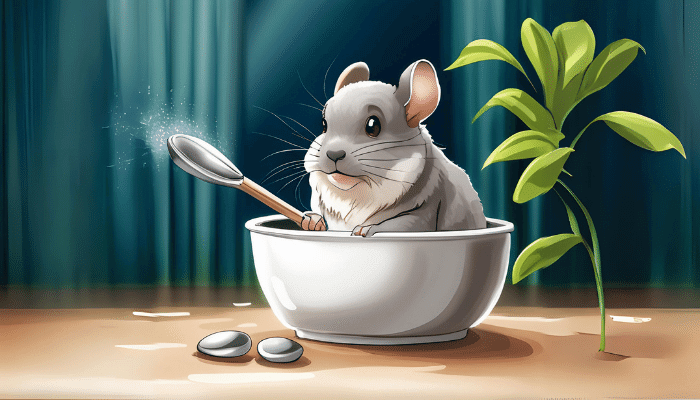
Chinchillas are low-maintenance animals, but they do require some specific care to keep them healthy and happy. Here are some of the basic care requirements for chinchillas:
Diet: Chinchillas need a diet that is high in fiber and low in fat. They should be fed a diet of hay, pellets, and fresh vegetables. It is important to avoid giving them sugary or fatty treats, as these can cause health problems.
Enclosure: Chinchillas need a large, spacious enclosure that allows them to move around and play. They are active animals that enjoy climbing and jumping, so their enclosure should have multiple levels and plenty of toys and hiding places.
Temperature: Chinchillas are sensitive to high temperatures and can easily overheat. Their enclosure should be kept in a cool, dry place that is out of direct sunlight.
Hygiene: Chinchillas are clean animals that groom themselves regularly. However, they still need regular cage cleaning to prevent the buildup of bacteria and ammonia. Their enclosure should be cleaned at least once a week, and their bedding should be changed regularly.
Explore our comprehensive chinchilla care guide for expert advice on keeping these adorable pets healthy and happy.

Baby Chinchilla
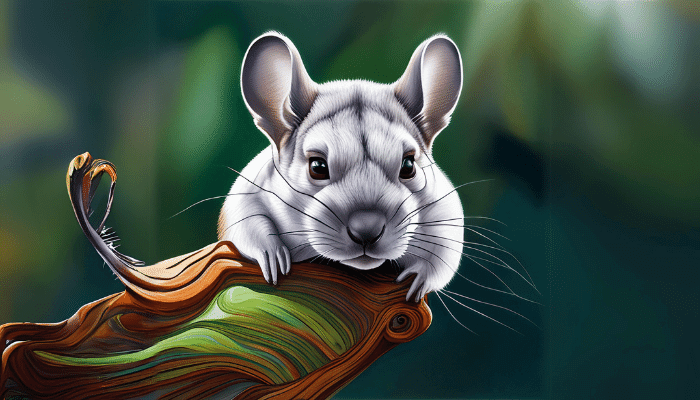
Baby chinchillas are incredibly adorable and charming creatures that belong to the rodent family. These small mammals are known for their soft and dense fur, large ears, and expressive eyes.
Baby chinchillas, also known as kits, are born with their eyes open and a soft fur coat. Their fur is usually grey or beige, but it can vary depending on the specific chinchilla breed. As they grow older, their fur may change color, and by the time they reach adulthood, they typically sport a luxurious and dense coat.
When born, baby chinchillas are tiny, weighing only a few ounces. However, they grow rapidly during the first few months of life. Adult chinchillas are generally small in size, with an average length of 9 to 15 inches (23 to 38 cm) and a weight ranging from 1 to 1.5 pounds (450 to 680 grams).
Baby chinchillas are known for their playful and curious nature. They love to explore their surroundings and are often seen hopping and jumping around joyfully. Chinchillas are social animals, so it’s recommended to keep them in pairs or small groups to prevent loneliness.
Chinchilla Health

Ensuring the well-being of chinchillas involves addressing specific aspects of their care. These small, furry rodents have delicate digestive systems, necessitating a specialized diet rich in high-fiber, low-fat components like quality hay.
Their living environment plays a crucial role, requiring spacious, well-ventilated cages with horizontal bars for exercise and cool, dry conditions. Regular hygiene maintenance, including dust baths and cage cleaning, is vital for their cleanliness. Routine veterinary check-ups with an experienced exotic animal veterinarian are essential, with careful monitoring for signs of illness.
Daily exercise, social interaction, and provision of dental care through appropriate chewing materials contribute to their physical and mental health. Attending to these aspects fosters responsible chinchilla ownership, ensuring the overall health and happiness of these delightful pets.
Chinchilla Breeds

Breeding chinchillas can be a rewarding experience for those interested in raising these adorable creatures. However, it requires careful planning and attention to detail to ensure the health and safety of the chinchillas involved.
To breed chinchillas, it is important to have a pair of the opposite sex. Chinchillas become sexually mature at around eight months old, and mating season takes place from about November until May in the northern hemisphere. When the female is receptive to mating, the male initiates by grooming the female and will copulate with her.
Once mating occurs, it is important to separate the male and female to prevent any aggression or harm. A pregnant chinchilla will give birth after 100 to 115 days.
When breeding chinchillas, it is important to ensure that the pair is healthy and of the right age for breeding. Introduce the male and female gradually in a comfortable enclosure, and monitor the breeding process closely.
Breeding chinchillas for a specific color mutation should be left to experienced breeders, as it can be a complex process. It is also important to note that chinchillas can develop health issues during pregnancy, such as pregnancy toxemia, so it is crucial to provide proper nutrition and veterinary care.
Overall, breeding chinchillas requires careful planning, attention to detail, and a commitment to the health and safety of the chinchillas involved.
Chinchilla Behaviour
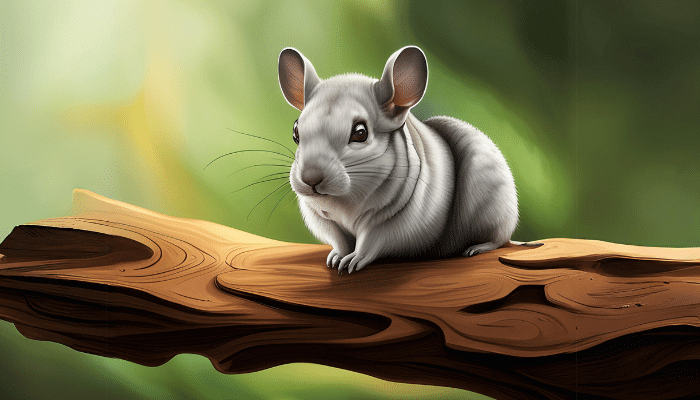
Chinchillas are social animals that require daily interaction and stimulation. They have a range of behaviors that can indicate their mood and health.
Chinchillas communicate with each other through a variety of sounds and body language. For example, a happy chinchilla may smile by curling its cheeks upward, and may also wink to show contentment or acknowledge communication from its owner. On the other hand, a stressed or frightened chinchilla may bark whistle, or hide in its cage.
Chinchillas are active creatures and require plenty of opportunities to play, climb, and run. They may engage in “wall surfing,” which involves running around, jumping up, and bouncing off walls. This behavior is a sign of a happy and healthy chinchilla, but can also be a sign of boredom or lack of stimulation.
While chinchillas are generally friendly and social, they may display aggressive behavior if they feel threatened or stressed. This can include biting, scratching, or even attacking other chinchillas. It is important to provide a safe and comfortable environment for chinchillas to prevent aggression.
Chinchillas may display bad behaviors such as chewing on objects, digging, or spraying urine. These behaviors can be caused by boredom, stress, or lack of proper training. Providing plenty of toys, hiding spots, and training can help prevent bad behaviors in chinchillas.
Chinchilla Housing
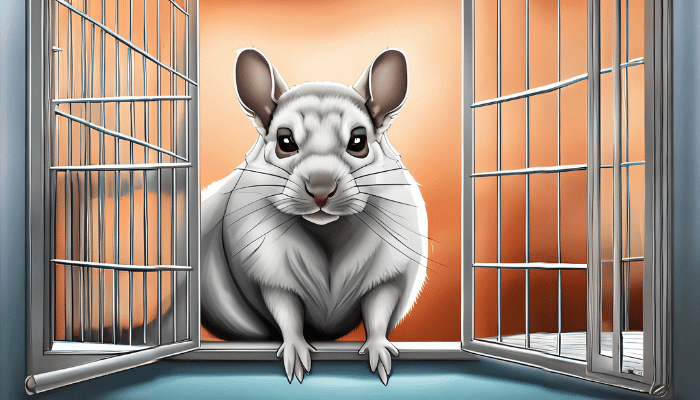
Creating the perfect housing for a chinchilla isn’t just a matter of throwing some bedding into a cage and calling it a day. Chinchillas are unique little critters with a knack for finding ways to make their environments fun and interesting. Now, a key factor when housing your fluffy friend is space.
Think larger rather than smaller their accommodation should be the Ritz Carlton of rodent living spaces! Height is another vital element since chinchillas are active climbers, hence the importance of having multiple levels. They’ll enjoy climbing from one tier to the next, akin to their miniature workout session.
And trust me, you won’t find them lounging around twiddling their tiny paws! Providing solid flooring is important as it keeps them comfortable and prevents injuries to their delicate little feet. Safety is key, after all! Let’s not forget, that wire floors can get as gnarly as a splinter in a kid’s foot.
For materials, it’s always best to opt for wood or metal since chinchillas have an insatiable need to chew, a plastic house wouldn’t stand a snowball’s chance in hell! And for that added homey feel, incorporating hiding spots is always a splendid idea; this could be anything from small houses to tunnel-like tubes where your chinchilla can escape and take a breather from its regular active schedule.
Their living area should be maintained at around 60-70°F, not a hair hotter or colder. Chinchilla housing may be a game of precise considerations, but the happiness of your furry is surely worth it all.
Chinchilla Fur Care
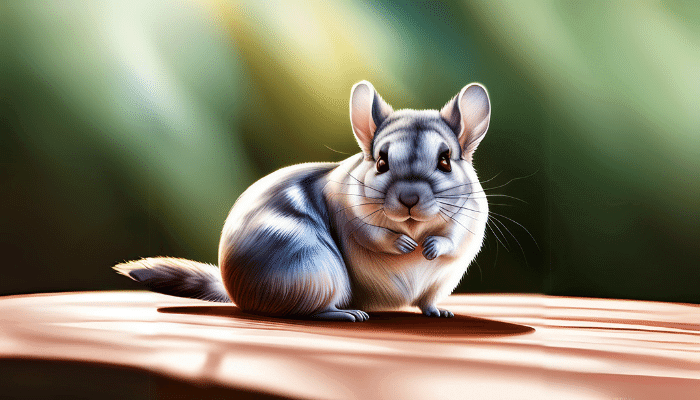
Giving your beloved Chinchilla the royal treatment they deserve extends beyond merely ensuring a healthy diet and ample playtime; it equally includes the exceptional care of their thick, plush, and sumptuous fur.
All you chinchilla owners! Here’s a little know-how about taking care of that lustrous fur, which, mind you, is thicker than that of most mammals! Ensuring the proper care of this delicate fur requires diligence and patience. Not only that, they require regular dust baths.
These tiny furry critters need their regular bathing regime to keep their fur in tip-top condition. These aren’t just your ordinary water baths, they roll around in special chinchilla dust made of fine pumice, and this keeps their coat shiny, and healthy and eliminates excess oil and moisture.
Make sure your furry friend has ample space for their frolicking bath times – that way, they can kick, roll, and just have a whale of a time. Moreover, take care to gently brush their coat frequently, without applying too much pressure, which can inadvertently harm their delicate skin underneath. In case you come across any matted or knotted fur, snip it away gently without distressing your fluffy buddy.
Sometimes, despite our best efforts, the inevitable happens and your chinchilla may encounter fur slip. This is when large chunks of fur fall off due to stress, improper handling, or even fear. Fear not, for it’s not a life-threatening situation and the fur eventually grows back in due time.
Fur care for a Chinchilla can be as unique as the Chinchilla itself, with each step promising not just a gorgeous coat but also happy times for you and your little pet! Remember to always monitor their fur for changes in texture, patches, or loss and ensure it stays clean, smooth, and glossy.
Chinchilla Fur Industry
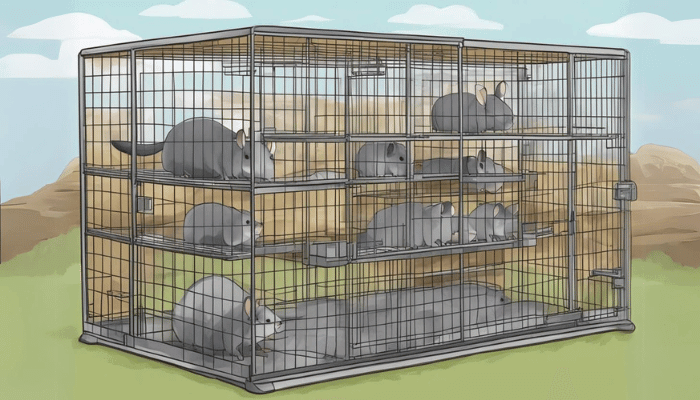
Chinchilla fur is highly valued for its softness, density, and luxurious appearance. The fur industry is responsible for the breeding and raising of chinchillas for their pelts.
One common method of killing chinchillas for their fur is cervical dislocation, where the chinchilla’s neck is broken. Other methods can include electrocution or gassing to death. The primary concern in the fur industry is that the chinchilla is killed without any damage to the fur.
Chinchilla fur coats are considered the most supple, delicate, and fine piece of clothing in the fur industry. Because of the soft texture of the fur, chinchilla fur coats are highly expensive. Most of the world’s farmed fur is produced by European farmers. Eighty-five percent of the fur industry’s skins come from animals living captive on fur factory farms.
These farms can hold thousands of animals, and the practices used to farm them are remarkably uniform around the globe. Chinchilla fur is often used in fashion and luxury goods, such as coats, hats, and accessories.
Chinchilla Training

Chinchilla training may seem like a daunting task. Still, with patience, love, and an understanding of your chinchilla’s unique needs, it can become an engaging and bonding experience.
These small creatures possess quite a bit of attitude. While training chinchilla, you have to adopt a very methodical and step-by-step approach. Initially, they might be somewhat reserved or aloof, almost cat-like. Wanting to understand whether you’re friend or foe.
Engaging with them through interactive play or treating them to tasty morsels can go a long way toward breaking down those walls. This can range from despite the language barrier, they can gauge your tone.
To their favorite snack (avoid sugary or fatty food, though). This positive reinforcement makes them equate training with happy memories, nudging them towards obedience.
Remember, we’re trying to make them feel loved and secure, not pushing them to join the Pet Olympics. Lastly, make sure to acknowledge their boundaries.
Chinchilla Playtime
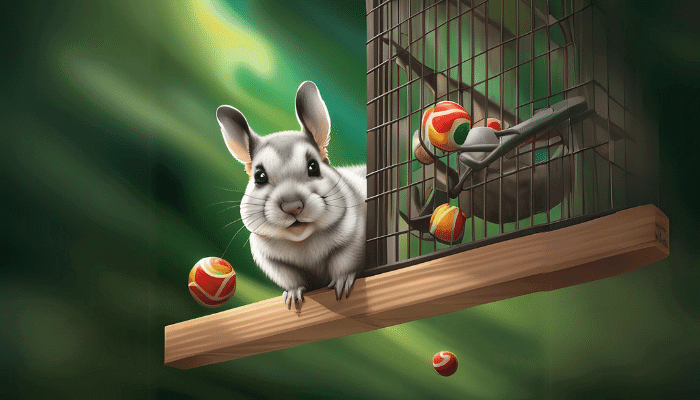
Chinchilla playtime is so much fun. When the cage opens, it’s party time for these little guys. They love jumping around, playing hide-and-seek in tunnels, and chasing toys that jingle. Like tiny acrobats, they show off their cool moves.
It’s a mix of fun and laughter as they scamper about, brushing against your fingers when you pat them. Whether they’re doing flips or playing tag, chinchilla playtime is a simple joy full of energy and adorable chaos.
Chinchilla Vocalizations
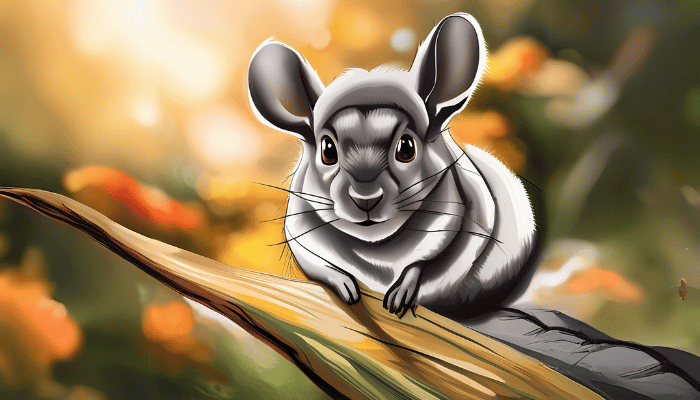
Chinchilla vocalizations are like a secret language giving you a peek into their feelings. When they make high-pitched squeaks, it’s like they’re happy or having fun. But watch out for grumbles and grunts that’s their way of saying something’s not right.
And the barks? Not like a dog, but a unique sound showing excitement or sometimes a bit of nervousness. These chinchillas have a way of talking that adds to their charm, making it feel like you’re having a chat with your friend.
Chinchilla Dental Health
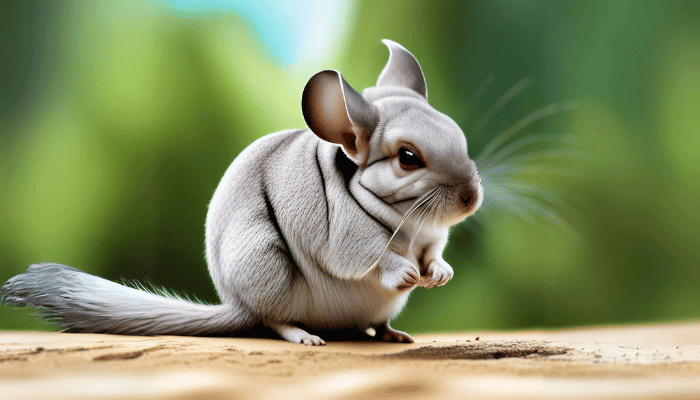
Chinchilla dental health is no joke. Taking care of your chinchilla’s teeth is crucial for their well-being. Chinchillas have teeth that grow continuously, and without proper care, it can lead to dental problems.
The key is to provide them with high-fiber hay, which helps keep their teeth in good shape. It’s like a dental workout for them! Additionally, offering wooden toys gives them something safe to chew on, promoting dental health. So, remember to keep the hay and throw in a few toys it’s the secret to a happy and healthy chinchilla smile.
Chinchilla Allergies

Exploring the world of chinchillas comes with surprises, and one unexpected thing is chinchilla allergies. Yes, you heard it right – these charming creatures can sometimes cause sneezes. Imagine being all excited about cuddle sessions, only to find that Mr. Whiskers is making you sneeze.
It’s like an interesting twist in the chinchilla story. Allergies aren’t a universal problem; they’re more like silent partners that can sneak up on both chinchillas and their human friends. Whether it’s the hay, bedding, or even the chinchilla dander, figuring out the cause can feel a bit like solving a mystery.
Hypoallergenic Chinchilla
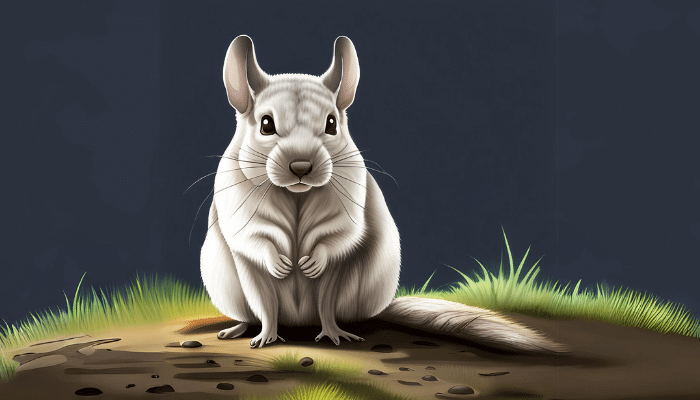
Step into the magical world of hypoallergenic chinchillas the unsung heroes of pet pals for allergy sufferers! These charming creatures redefine the pet experience with their enchanting fur coats, promising cuddles without a hint of sniffles or sneezes.
Imagine a world where bonding with your chinchilla is a dreamy reality, free from allergy-induced setbacks! These lovable little buddies are hypoallergenic, meaning they’re less likely to trigger those pesky allergies. No more sniffling, sneezing, or itchy eyes.
Plus, with their super-dense fur, those tiny allergens stay put, making the air allergy-free. Just a friendly tip: keep your chinchilla’s space tidy for maximum allergy-free happiness!
Chinchilla Dust Bath
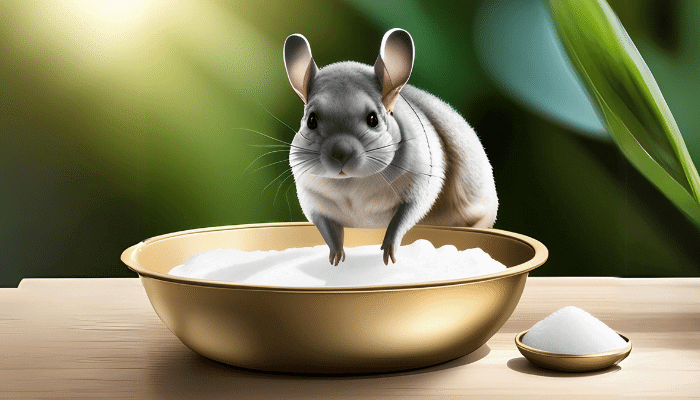
Have you ever marveled at your delightful furry companion’s love for frolicking in the dust? It’s not just quirky behavior. It’s their secret to staying impeccably clean and luxuriously cozy. Your Chinchilla, a true nature enthusiast, hails from the majestic Andes, where dust baths are the ultimate spa treatment for their precious fur.
Imagine sprinkling fine-grain chinchilla dust into a bespoke bathhouse within their cage, providing your beloved pet with a lavish haven for delightful rolling sessions. But wait, there’s a golden rule time it just right around 10-15 minutes, to ensure the perfect pampering without going overboard.
Twice a week is the enchanted number. From selecting the finest dust to handling a slightly reluctant chinchilla, we’ve got you covered. Treat your cherished pet to this sensory indulgence.
Chinchilla Lifespan

Chinchillas are known for their long lifespan compared to other pet rodents. In the wild, they typically live around 10 years, while in captivity, they can thrive for even longer, sometimes up to 20 years or more with proper care.
It is important to note that chinchillas are fragile animals, and their lifespan can be affected by various factors such as diet, environment, and genetics. For example, chinchillas that are kept in dirty or cramped living conditions may have a shorter lifespan than those living in a clean and spacious environment.
Chinchillas are prone to certain health issues such as dental problems, respiratory infections, and gastrointestinal issues, which can also affect their lifespan. It is crucial to provide them with a nutritious diet, ensure a comfortable living environment, and regular health check-ups to increase their lifespan.
It’s also important to note that chinchillas have a longer gestation period than most rodents, at 111 days. They are born fully furred and with their eyes open, which is unique compared to other rodents.
Overall, chinchillas can live a long and healthy life with proper care and attention to their needs.
Chinchilla Tail Wagging
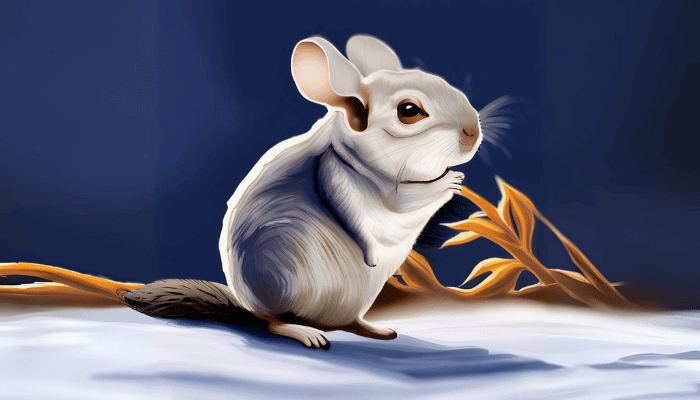
Ever noticed your chinchilla’s tail doing a little wiggle? That’s called Chinchilla Tail Wagging, and it’s their way of talking without words. Imagine it like a happy dance a tiny tail expression that means your chinchilla is feeling joyful and content.
It’s their language of happiness! They use it to chat with other chinchillas and show how they feel. Giving your chinchilla a fun home with toys and cozy spots encourages this adorable tail wagging.
But remember, if you ever see big changes or your chinchilla stops wiggling its tail, it’s like a signal that they might not be feeling their best. Keep an eye on them, give them a healthy diet, and enjoy the tall tales.
Chinchilla Fur Chewing
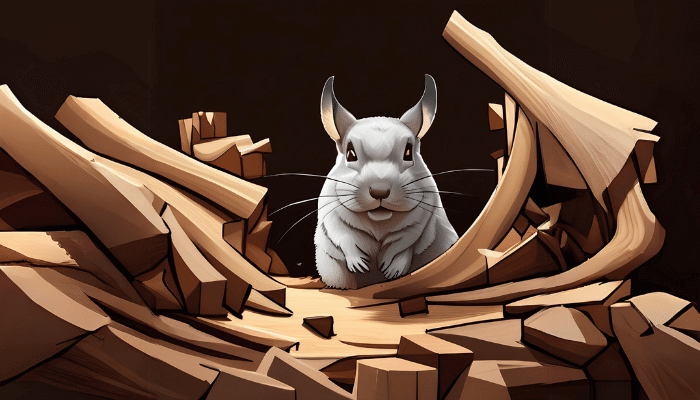
If you’ve ever caught your chinchilla nibbling its fur. When chinchillas chew on their fur, it usually means something’s going on. It could be boredom, stress, teeth trouble, a diet hiccup, or maybe they just need a chinchilla buddy.
To stop this fur-chewing business, keep them entertained, chill out their environment, check their food, care for their teeth, and think about a furry friend. And in case you’re curious, we’ve got some.
FAQs covered like, is it harmful? Yep, a bit. Is it common? Depends. Can it be fixed? Often, yes.
Chinchilla Safe Food
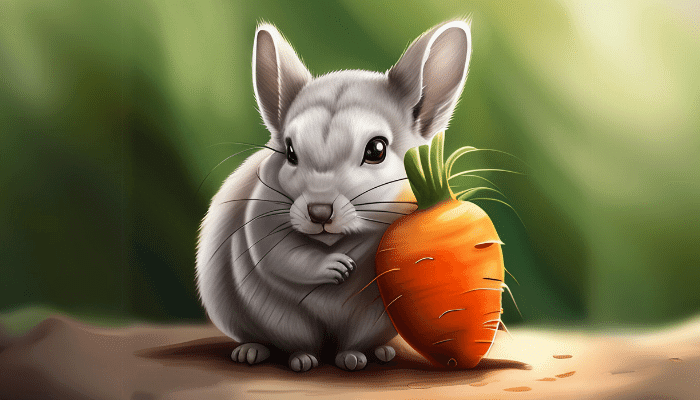
Knowing what to feed your chinchilla is key to keeping them healthy and happy. Their diet should be high in fiber and low in sugar, fat, and salt. Hay should be their main staple (around 80% of their diet), supplemented with high-quality pellets and occasional safe treats like fruits, vegetables, and some nuts and seeds.
Remember, moderation is key with treats, as they should only make up 10% of their daily intake. By avoiding harmful foods and focusing on chinchilla-safe options, you can ensure your furry friend thrives for years to come.
Safe Wood for Chinchillas
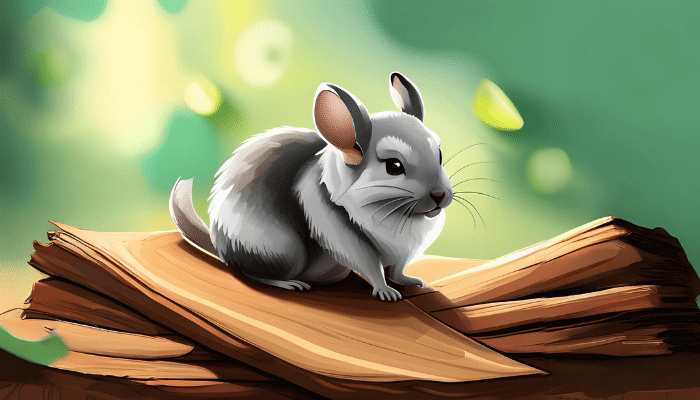
Chinchillas are adorable rodents that require specific care. One important aspect of their well-being is providing them with safe wood for chewing. Chewing helps keep their teeth healthy and prevents them from becoming overgrown.
There are many safe wood options available, including apple, aspen, and cottonwood. However, some types of wood can be toxic to chinchillas and should be avoided.
When choosing safe wood, it’s important to source it from a reputable supplier, wash it thoroughly before giving it to your chinchilla, and supervise them while they chew.
Additionally, offer your chinchilla other chew toys, such as pumice stones and hay cubes, to keep them entertained and prevent them from chewing on unsafe objects.
How Much Is a Chinchilla?

The cost of a chinchilla can vary greatly depending on several factors, including color, breed, age, gender, lineage, and location. Expect to pay between $75 and $300 for the initial purchase.
Beyond the chinchilla itself, you’ll need to budget for a cage and supplies ($200-$500), food ($30-$50 per month), vet care ($100-$200 per year), and potential additional costs. This means the total estimated annual cost of owning a chinchilla can range from $720 to $1,720.
Before making a decision, carefully consider your budget and lifestyle and ensure you can provide the necessary long-term commitment and specialized care. For more information on chinchilla care, check out the resources provided!
Do Chinchillas Need Baths?
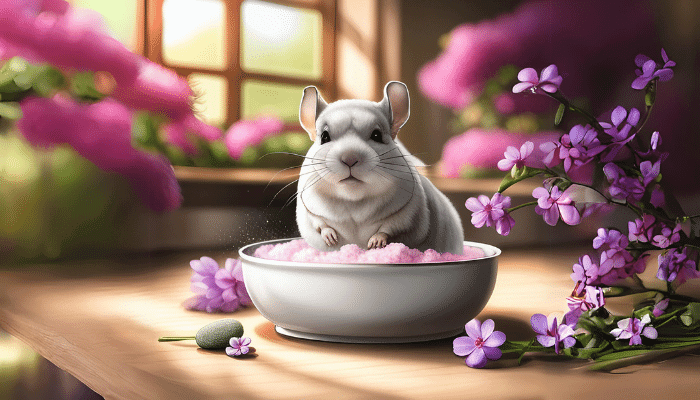
Chinchillas keep themselves clean with dust baths. They instinctively roll around in this special dust, removing dirt and oils from their fur and keeping it healthy and fluffy. It’s essential for their well-being, so providing a dust bath regularly is crucial.
Remember, frequency matters aim for twice a week, but no more than four times. And leave the water baths to exceptional situations like spills or skin conditions. Your chinchilla’s dust bath is their secret to stunning fur and a happy life.
Do Chinchillas Bite?
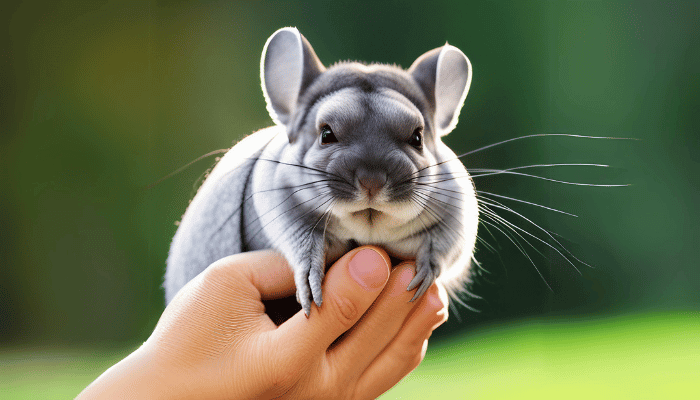
Chinchillas are furry friends, but like any animal, they can bite. While not their first choice, they might resort to biting if they feel scared, uncomfortable, or stressed. This could be due to sudden movements, loud noises, pain, territorial instincts, lack of socialization, boredom, or even misinterpreting your scent as food.
By understanding their triggers, building trust through gentle handling, and creating a stimulating environment, you can prevent bites and build a strong bond with your fluffy companion. Remember, patience and respect go a long way in creating a happy and bite-free relationship with your chinchilla.
Are Chinchillas Good Pets?

Thinking about welcoming a fluffy friend into your home? Chinchillas are adorable, clean, and relatively low-maintenance. They thrive in apartments thanks to their quiet nature and dust baths that keep their fur odorless.
However, they require specific care, including a spacious cage, specialized diet, and regular playtime. Chinchillas can be playful companions for patient owners who understand their unique needs.
How Big Do Chinchillas Get?
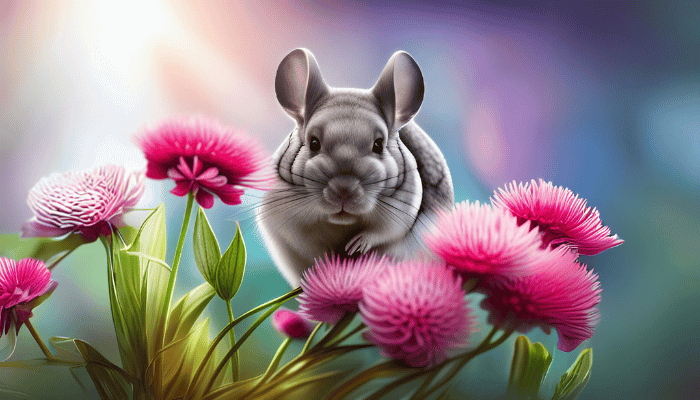
Chinchillas are small, adorable rodents that make great pets for people with limited space. These typically grow to be 10-14 inches long, excluding their bushy tail which adds another 3-6 inches. Their weight ranges from 1-1.5 pounds, with females being slightly larger than males.
Their size is influenced by several factors, including breed, genetics, diet, and exercise. Long-tailed chinchillas tend to be bigger, while short-tailed are more petite. Proper nutrition and exercise are crucial for their health and growth.
Chinchillas reach their full size around 8-12 months old. They require spacious cages with climbing structures and dust baths to thrive.
Overall, chinchillas are small and manageable pets with unique personalities and soft fur. If you’re looking for a cuddly companion, consider welcoming one of these charming creatures into your life.
Can chinchillas eat raspberries?

Chinchillas are fluffy, adorable creatures, but their diet can be tricky. Can they eat raspberries? Unfortunately, no. Their sensitive digestive systems can’t handle the high sugar content, leading to potential health problems.
While a single bite might not be harmful, it’s best to avoid them altogether. Instead, stick to hay, specific pellets, and safe treats like dried rose hips and dandelion roots to keep your furry friend happy and healthy.
Can Chinchillas Eat Sunflower Seeds?
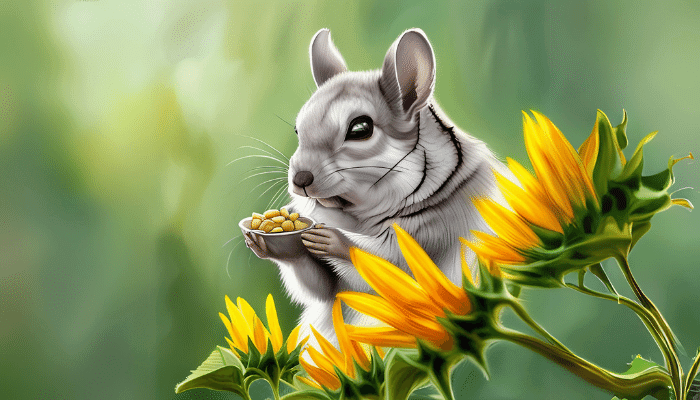
While sunflower seeds are not poisonous to chinchillas, they aren’t the best choice for their diet. They’re high in fat and low in fiber, which can lead to health problems like obesity, liver disease, and digestive issues.
While you can offer a small amount as an occasional treat (1-2 seeds per week), it’s best to stick to their regular diet of high-quality hay, pellets, and other healthy treats like fruit tree branches, rose hips, and oatmeal. Always consult your veterinarian before introducing any new food to your chinchilla’s diet.
Can Chinchillas Eat Coconut?
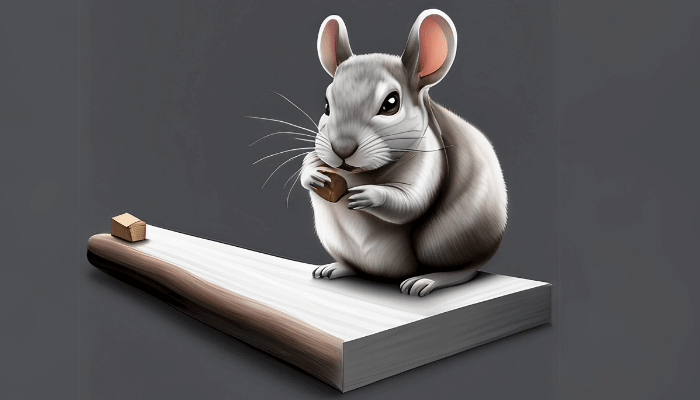
Yes, Chinchillas can eat coconut, but only in small amounts and with extreme caution. it’s high in fat and sugar, which are detrimental to their health. Coconut shells are also a choking hazard due to their sharp edges.
If you offer coconut to your chinchilla, make sure it’s organic and free of any chemicals or additives. You should also remove the hard outer shell and any remaining husk before offering it to your furry friend.
Remember, coconut is just a treat, and your chinchilla’s main diet should consist of high-quality timothy hay and a specially formulated chinchilla food.
Here are some other safe and healthy treats you can give your chinchilla:
Always monitor your chinchilla closely after giving them any new food, and consult your veterinarian if you have any concerns.tunesharemore_vertadd_photo_alternate
How to Tell If a Chinchilla Is Pregnant?

Chinchilla pregnancy lasts about 16 weeks, and while early signs might be subtle, weight gain, nipple development, and nesting behavior are some clues. Offer a spacious cage with a cozy nesting box, high-quality food, and clean water.
Leave the family alone after birth, monitor temperature, and schedule vet checkups. Avoid handling them until 3-4 weeks old, then slowly introduce solid food. Wean them between 6-8 weeks and separate by sex by 10-12 weeks. Provide dust baths, enrichment activities, and socialize to create happy, healthy chinchillas.
How To Take Care of a Chinchilla?
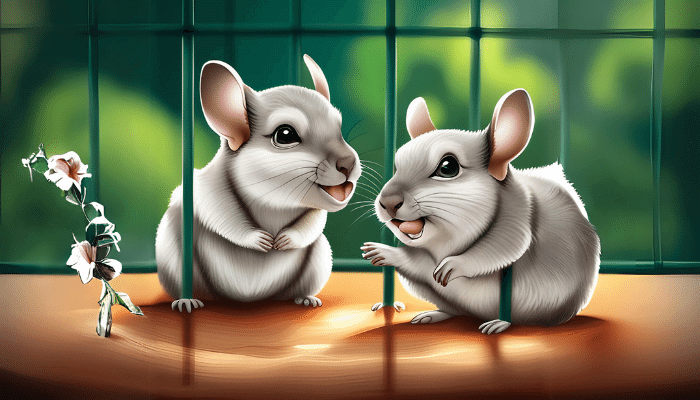
Chinchillas are adorable fluffy pets, but they require specific care. To keep them happy and healthy, you’ll need to provide them with a spacious cage, dust-free bedding, a cool and dry environment, a diet of hay, pellets, and occasional treats, and access to fresh water.
They also need plenty of exercise and playtime outside their cage, and a dust bath at least twice a week. Chinchillas are social animals, so they do best when kept in pairs or small groups. Regular veterinary checkups are also important to monitor their health. With proper care, chinchillas can live for 15 to 20 years.
How Do I Groom My Chinchilla?
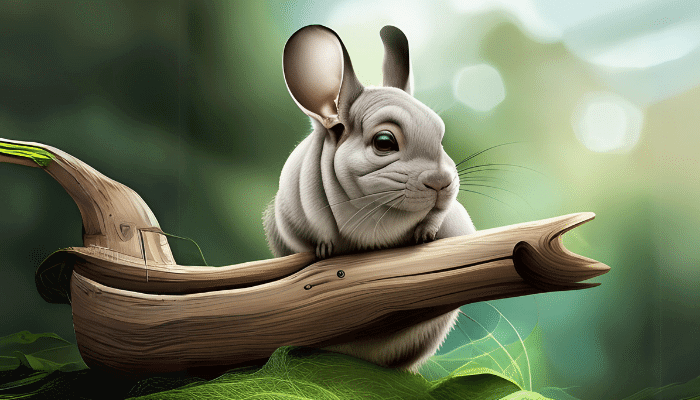
Taking care of your chinchilla is simple! Just remember to feed them high-quality pellets and hay, provide a dust bath for their fur, and keep their cage clean. Don’t forget to let them exercise in a large space with a safe wheel and climbing structures.
Keep an eye out for any signs of illness and take them to the vet for regular check-ups. With a little love and care, your chinchilla will be a happy and healthy friend for years to come.
Can Chinchillas Live Outside?
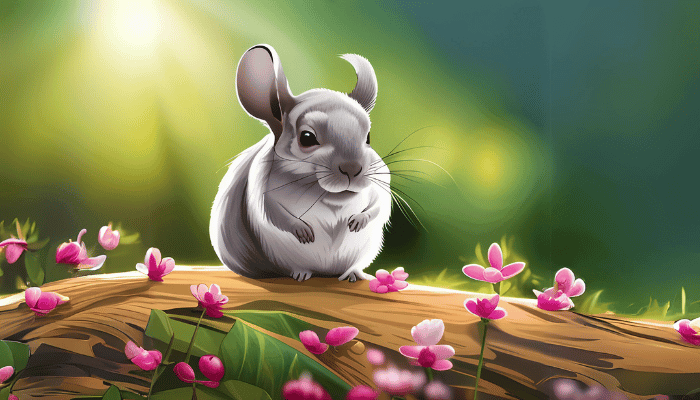
Chinchillas are adorable and fluffy pets, but can they live outside? Unfortunately, the answer is no. While they can tolerate cold weather, they are very sensitive to extreme temperatures, humidity, and direct sunlight.
These factors can lead to health problems like heatstroke, hypothermia, and respiratory issues. Additionally, keeping them outside requires a secure and spacious enclosure with temperature control, which can be difficult to manage.
Therefore, the best way to ensure your chinchilla’s health and happiness is to keep them as an indoor pet. Provide them with a spacious cage, maintain a comfortable temperature, offer regular dust baths, and schedule supervised playtime for exercise and interaction. By following these simple tips, you can create a loving home for your furry friend.
Chinchilla and Climate

Chinchillas, adorable mountain dwellers with fluffy fur and playful personalities, face a growing threat: climate change. As temperatures rise and their habitat shrinks, these furry ambassadors of the Andes struggle with heat stress, food scarcity, and increased competition.
We can help by reducing our carbon footprint, supporting conservation efforts, and spreading awareness to ensure their survival for generations to come. Let’s work together to safeguard these fascinating creatures and protect our planet for all.
Chinchilla History and Evolution

Chinchillas are adorable rodents native to the high altitudes of the Andes Mountains. They are also very social creatures and live in colonies called “herds.” Chinchillas have a fascinating history, from being revered by the Incas to facing near extinction due to over-hunting for their fur. Today, they are popular pets and conservation efforts are working to ensure their survival.
Chinchillas have several unique adaptations that help them survive in their harsh environment. These include their dense fur, large eyes, powerful legs, and continuously growing teeth. They are also crepuscular, meaning they are most active at dawn and dusk.
Chinchillas can be great pets for responsible owners. They are intelligent, social creatures and can form strong bonds with their humans. However, they require a spacious cage, cool temperature, and a specialized diet.
With proper care, chinchillas can live 15-20 years in captivity. They are not currently endangered, but habitat loss and the illegal fur trade continue to pose threats. You can learn more about chinchillas and how to help them by visiting the websites of reputable organizations such as the Chinchilla Conservation Center and the National Chinchilla Breeders Association.
Legal and Ethical Issues
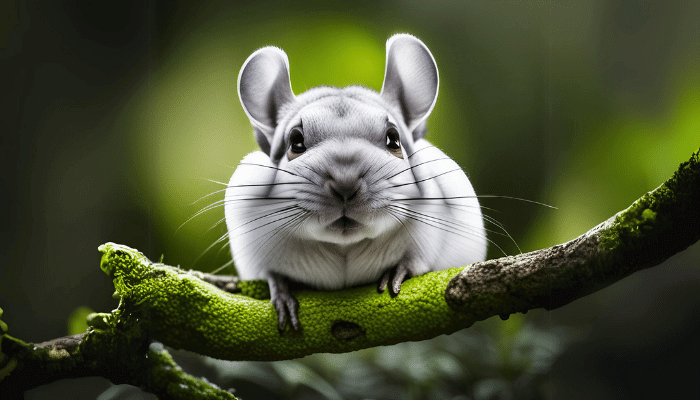
Chinchillas, prized for their luxuriously soft fur, face a complex ethical landscape in the pet and fur industries. Despite the Animal Welfare Act setting minimum standards for animal care, chinchillas often endure inadequate living conditions and inhumane treatment.
Moulton Chinchilla Ranch, a major supplier in the US, has faced numerous animal welfare violations, exceeding 100 documented instances. Undercover investigations conducted by PETA revealed disturbing practices: chinchillas were housed in cramped, unhygienic cages with limited access to food, water, and essential care. Additionally, reports of painful procedures, like tooth clipping with no anesthesia, further highlight the ethical concerns surrounding the ranch’s practices.
The use of chinchilla fur in luxury fashion raises significant ethical concerns. Chinchilla fur coats, considered a status symbol, often come at a heavy price for the animals. Cramped cages, unsanitary conditions, and cruel harvesting methods, often involving electrocution or live skinning, have garnered criticism from animal rights organizations like PETA, who advocate for a complete ban on chinchilla fur in fashion.
In response to ethical concerns and growing public awareness, some companies have introduced synthetic alternatives to chinchilla fur. While this offers a seemingly cruelty-free option, synthetic materials often come with their own environmental drawbacks. Petroleum-based materials and long-term decomposition raise sustainability concerns. Thankfully, consumers are increasingly seeking ethical and sustainable alternatives like recycled or upcycled materials, offering a more responsible approach to fashion.
The chinchilla industry faces a critical juncture. Addressing ethical concerns and ensuring humane treatment throughout the breeding, care, and harvesting processes is crucial. Additionally, promoting transparency and ethical sourcing practices is essential for rebuilding consumer trust. As the demand for sustainable and ethical products continues to evolve, the chinchilla industry must adapt and prioritize the well-being of these remarkable animals.
Conclusion
To conclude, chinchillas are fascinating and unique creatures that can make wonderful pets for responsible owners who are willing to provide them with the specialized care they require. Their playful personalities, soft fur, and relatively low-maintenance nature make them a popular choice for many.
However, it is important to be aware of the ethical concerns surrounding the fur industry and ensure that any chinchilla you welcome into your home comes from a reputable breeder who prioritizes the welfare of their animals.
By providing your chinchilla with a spacious cage, cool temperature, proper diet, and plenty of love and attention, you can ensure they live a long and happy life.
Frequently Asked Questions
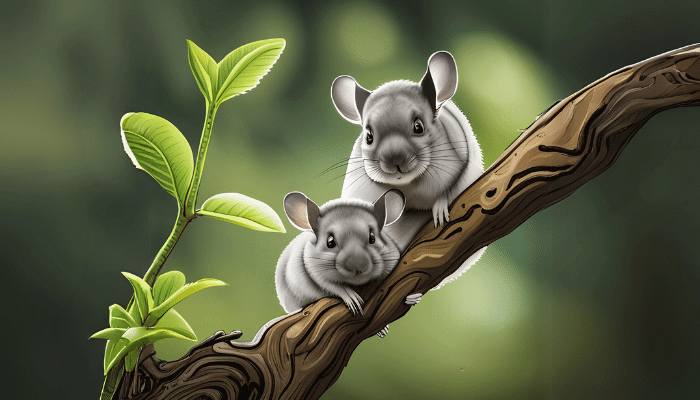
What do chinchillas eat?
Chinchillas are herbivores and their diet should mainly consist of high-quality hay. They should also be given a small amount of pellets and fresh vegetables as treats. Chinchillas should never be given sugary or fatty foods, as these can cause health problems.
How often do chinchillas need dust baths?
Chinchillas need dust baths at least twice a week to keep their fur clean and healthy. The dust bath should be made of fine-grain chinchilla dust, and it should be big enough for the chinchilla to roll around in comfortably.
How long do chinchillas live?
Chinchillas can live for 15-20 years in captivity with proper care.
What is the best way to handle a chinchilla?
Chinchillas are fragile creatures and should be handled with care. It is important to support their body weight and to avoid sudden movements. Chinchillas should never be picked up by their tail.
What are some signs that a chinchilla is sick?
Some signs that a chinchilla is sick include lethargy, loss of appetite, weight loss, runny nose, and matted fur. If you notice any of these signs, it is important to take your chinchilla to the vet right away.
Are chinchillas good pets for children?
Chinchillas can be good pets for children who are old enough to understand how to handle them gently. It is important to supervise children when they are around chinchillas.
Are chinchillas expensive to care for?
Chinchillas can be expensive to care for, as they require a spacious cage, a specialized diet, and regular vet checkups. However, the cost is worth it for many people who enjoy the companionship of these adorable creatures.



































